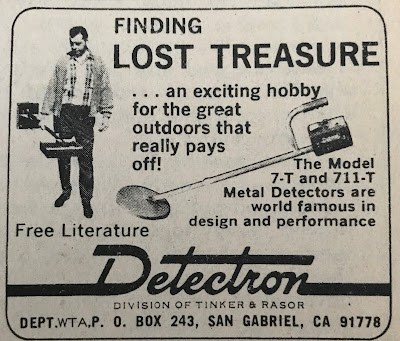Another anonymous diver worked the American, Feather, and Yuba rivers in the heart of the California Mother Lode country. Fourteen thousand dollars in rich nuggets and flake gold was popped out of these streams during clandestine weekend forays. "The guy even had his wife and kids helping out," laughed Stillson. "His name? Wouldn't Uncle Sam's income tax boys like to know?"
Our man Warren Smith put together this slick little treasure hunting guide, aimed straight at the dark heart of midcentury suburban dads dreaming of easy money. The table of contents lays it out: first is a section of real life finds like the $50,000 in "Spanish treasure" found off the coast of Florida by one Jack Steffney and friends:
 |
This AP clipping is from the St. Louis Post-Dispatch, November 1966, though for some reason Smith dates the story to February of 1967, his year of publication. |
These early chapters are meant to whet our appetite for treasure, and Smith follows them with the second section of the book, how-to chapters on various types of treasure hunting: gold dredging, salvage diving, metal detecting, and even guided expeditions - this last option being a little bit more than a weekend lark, as Smith even titles this chapter "The Man Who Brings You Back Alive!" - that man being Ray Dorr, of Coronado Expeditions, who takes paying guests into the wastes of the American Southwest and Northern Mexico for $50 a day on the promise of big strikes. Dorr says the cost is worth it, as he knows the country and the people, and that without his guidance "the average American insults the rural Mexican [even] by the way he shakes his hand!" Smith lists off some manufacturers of treasure gadgets in their appropriate chapters. Gold dredge manufacturers include:
Western Sports, 3030 East 15th St., Spokane, Wash.
Gold Divers, 3534 Rosecrans Avenue, Hawthorne, Calif.
Keene Engineering Company, 11483 Vanowen St., North Hollywood, Calif.
While metal detecting companies include:
Fisher Research Laboratory, 1975 University Avenue, Palo Alto, Calif.
Underground Explorations, Box 793, Menlo Park, Calif.
The Goldak Company, 1544 West Glenoaks Blvd., Glendale, Calif.
Rayscope Company, P.O. Box 715, North Hollywood, Calif.
Gardiner Eectronics [sic] Co., 4729 North 7th Avenue, Phoenix, Ariz.
Art Howe and Company, 811 Kansas Avenue, Atchison, Kans.
John Green, 337 First Parish Road, Sciture, Mass.
D-Tex Electronics, 3326 Broadway, Garland, Texas.
White's Electronics, 1218 Main St., Sweet Home, Ore.
Relco Company, Box 10563, Houston, Texas.
Karl Von Mueller, Examino, Weeping Water, Nebraska.
Smith also advises readers to write Mr. von Mueller for a copy of his Examino Express, a metal detecting newspaper. Metal detecting takes up a lot of space in this section, and for good reason: it's the most accessible kind of treasure hunting, done as Smith says on weekends or short vacations, in parks, beaches, or even your own backyard! Smith also recommends dragooning your wife and kids into treasure trips! There are some great vintage ads for metal detectors compiled in a thread on the Detector Prospector forum:
Fate magazine also sometimes featured ads for metal detectors, an example of the crossover in self-help/get-rich-quick ideas and the paranormal/occult field. The ad below looks to be for some kind of dowsing rod device, which means your mileage may vary if you want something that actually works as advertised!
 |
| From the December 1975 issue of Fate |
We also get prices for baby elephants, tigers, zebras, camels and more ... talk about a different time! This chapter also showcases another editing gaffe, wherein Smith doesn't introduce the Englishman who gives some obviously made-up line about the "bloody big" panda mating operation. Later on page 135 the steamer ship Goliath typos as "Goliah" several times. After this big chunk of treasure tales Smith ends with a list of additional potential finds state by state, and then an index for each state's treasures. Some of the entries are a little thin: in South Carolina, we're told, gold panners have reported "good color" in "streams along the border of North and South Carolina." Thanks, Warren!
Nevertheless, I have to credit Smith in one regard: all of his entries appear to cite true events, rumors, and legends. That is to say, he doesn't appear to have manufactured any of these treasures out of thin air, even if some of them might truly be phantoms, and others exaggerations - maybe that's why he left out Oak Island this time around, as it's such a nonstarter for real treasure hunting. The tales Smith did include are all good enough for his purposes: that we want to believe we might be one of the lucky ones, that we might find one of these lost treasures and strike it rich. Whether or not we even ever pick up a metal detector, or simply daydream in our easy chair about a million dollar windfall, we paid the 60 cent cover price!
Finders Keepers is available to read and download at archive dot org.
Belmont Books, 1967














No comments:
Post a Comment